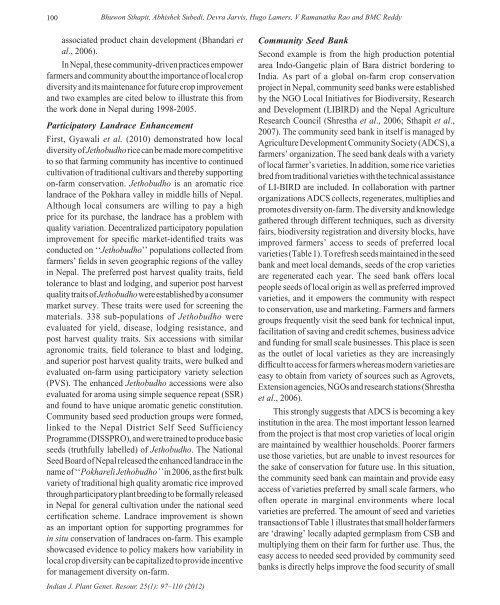indian society of plant genetic resources - Bioversity International
indian society of plant genetic resources - Bioversity International
indian society of plant genetic resources - Bioversity International
Create successful ePaper yourself
Turn your PDF publications into a flip-book with our unique Google optimized e-Paper software.
100<br />
Bhuwon Sthapit, Abhishek Subedi, Devra Jarvis, Hugo Lamers, V Ramanatha Rao and BMC Reddy<br />
associated product chain development (Bhandari et<br />
al., 2006).<br />
In Nepal, these community-driven practices empower<br />
farmers and community about the importance <strong>of</strong> local crop<br />
diversity and its maintenance for future crop improvement<br />
and two examples are cited below to illustrate this from<br />
the work done in Nepal during 1998-2005.<br />
Participatory Landrace Enhancement<br />
First, Gyawali et al. (2010) demonstrated how local<br />
diversity <strong>of</strong> Jethobudho rice can be made more competitive<br />
to so that farming community has incentive to continued<br />
cultivation <strong>of</strong> traditional cultivars and thereby supporting<br />
on-farm conservation. Jethobudho is an aromatic rice<br />
landrace <strong>of</strong> the Pokhara valley in middle hills <strong>of</strong> Nepal.<br />
Although local consumers are willing to pay a high<br />
price for its purchase, the landrace has a problem with<br />
quality variation. Decentralized participatory population<br />
improvement for specifi c market-identifi ed traits was<br />
conducted on ‘‘Jethobudho’’ populations collected from<br />
farmers’ fi elds in seven geographic regions <strong>of</strong> the valley<br />
in Nepal. The preferred post harvest quality traits, fi eld<br />
tolerance to blast and lodging, and superior post harvest<br />
quality traits <strong>of</strong> Jethobudho were established by a consumer<br />
market survey. These traits were used for screening the<br />
materials. 338 sub-populations <strong>of</strong> Jethobudho were<br />
evaluated for yield, disease, lodging resistance, and<br />
post harvest quality traits. Six accessions with similar<br />
agronomic traits, fi eld tolerance to blast and lodging,<br />
and superior post harvest quality traits, were bulked and<br />
evaluated on-farm using participatory variety selection<br />
(PVS). The enhanced Jethobudho accessions were also<br />
evaluated for aroma using simple sequence repeat (SSR)<br />
and found to have unique aromatic <strong>genetic</strong> constitution.<br />
Community based seed production groups were formed,<br />
linked to the Nepal District Self Seed Sufficiency<br />
Programme (DISSPRO), and were trained to produce basic<br />
seeds (truthfully labelled) <strong>of</strong> Jethobudho. The National<br />
Seed Board <strong>of</strong> Nepal released the enhanced landrace in the<br />
name <strong>of</strong> ‘‘Pokhareli Jethobudho’’ in 2006, as the fi rst bulk<br />
variety <strong>of</strong> traditional high quality aromatic rice improved<br />
through participatory <strong>plant</strong> breeding to be formally released<br />
in Nepal for general cultivation under the national seed<br />
certifi cation scheme. Landrace improvement is shown<br />
as an important option for supporting programmes for<br />
in situ conservation <strong>of</strong> landraces on-farm. This example<br />
showcased evidence to policy makers how variability in<br />
local crop diversity can be capitalized to provide incentive<br />
for management diversity on-farm.<br />
Indian J. Plant Genet. Resour. 25(1): 97–110 (2012)<br />
Community Seed Bank<br />
Second example is from the high production potential<br />
area Indo-Gangetic plain <strong>of</strong> Bara district bordering to<br />
India. As part <strong>of</strong> a global on-farm crop conservation<br />
project in Nepal, community seed banks were established<br />
by the NGO Local Initiatives for Biodiversity, Research<br />
and Development (LIBIRD) and the Nepal Agriculture<br />
Research Council (Shrestha et al., 2006; Sthapit et al.,<br />
2007). The community seed bank in itself is managed by<br />
Agriculture Development Community Society (ADCS), a<br />
farmers’ organization. The seed bank deals with a variety<br />
<strong>of</strong> local farmer’s varieties. In addition, some rice varieties<br />
bred from traditional varieties with the technical assistance<br />
<strong>of</strong> LI-BIRD are included. In collaboration with partner<br />
organizations ADCS collects, regenerates, multiplies and<br />
promotes diversity on-farm. The diversity and knowledge<br />
gathered through different techniques, such as diversity<br />
fairs, biodiversity registration and diversity blocks, have<br />
improved farmers’ access to seeds <strong>of</strong> preferred local<br />
varieties (Table 1). To refresh seeds maintained in the seed<br />
bank and meet local demands, seeds <strong>of</strong> the crop varieties<br />
are regenerated each year. The seed bank <strong>of</strong>fers local<br />
people seeds <strong>of</strong> local origin as well as preferred improved<br />
varieties, and it empowers the community with respect<br />
to conservation, use and marketing. Farmers and farmers<br />
groups frequently visit the seed bank for technical input,<br />
facilitation <strong>of</strong> saving and credit schemes, business advice<br />
and funding for small scale businesses. This place is seen<br />
as the outlet <strong>of</strong> local varieties as they are increasingly<br />
diffi cult to access for farmers whereas modern varieties are<br />
easy to obtain from variety <strong>of</strong> sources such as Agrovets,<br />
Extension agencies, NGOs and research stations (Shrestha<br />
et al., 2006).<br />
This strongly suggests that ADCS is becoming a key<br />
institution in the area. The most important lesson learned<br />
from the project is that most crop varieties <strong>of</strong> local origin<br />
are maintained by wealthier households. Poorer farmers<br />
use those varieties, but are unable to invest <strong>resources</strong> for<br />
the sake <strong>of</strong> conservation for future use. In this situation,<br />
the community seed bank can maintain and provide easy<br />
access <strong>of</strong> varieties preferred by small scale farmers, who<br />
<strong>of</strong>ten operate in marginal environments where local<br />
varieties are preferred. The amount <strong>of</strong> seed and varieties<br />
transactions <strong>of</strong> Table 1 illustrates that small holder farmers<br />
are ‘drawing’ locally adapted germplasm from CSB and<br />
multiplying them on their farm for further use. Thus, the<br />
easy access to needed seed provided by community seed<br />
banks is directly helps improve the food security <strong>of</strong> small

















